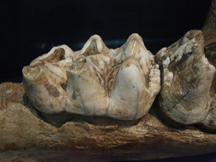
|
||||
|
|
||||
|
|
|
Mastodon State Historic Site, Imperial, Missouri
07.22.2006 -- Mastodon State Historic Site is located in
Imperial, Missouri, about twenty miles south of St. Louis,
just off I-55 (Exit 186). It contains an important
archaeological and paleontological site -- the Kimmswick Bone
Bed, where scientists discovered the first solid evidence of
the coexistence of humans and the American mastodon in At the end of the ice age that occurred from 35,000 to 10,000 years ago, the glaciers to the north were slowly melting as the earth warmed. Animals such as giant ground sloths, peccaries, and hairy, elephantlike mastodons roamed the Midwest. Paleontologists theorize that the area was once swampy and contained mineral springs. Animals that came to the springs may have become trapped in the mud, which helped preserve their bones. Early American Indians (known as paleo-indians) had also reached present-day Missouri by at least 12,000 years ago. For a brief period at the end of the Pleistocene epoch, the lives of humans and mastodons intertwined. The first recorded report of bones of mastodons and other now-extinct animals in the vicinity of the town of Kimmswick was in the early 1800s. St. Louis Museum owner, Albert C. Koch, Ph.D., investigated a report of bones weathering out of the banks along Rock Creek and conducted excavations in 1839, Thinking he had discovered a new animal, he named his find the Missouri Leviathan and exhibited it in the United States and Europe. Richard Owen, a comparative anatomist at the British Museum in London, convinced Koch the skeleton was actually an American mastodon. The Kimmswick Bone Bed is important in the history of archaeological discovery, as well as a rare example of a stratified ice age Paleo-Indian Clovis culture hunting activity, and one of the oldest known archaeological sites in Missouri (over 10,000 years old). Presently the Clovis culture is the earliest well-documented Native American occupation for North America. Clovis hunters may have contributed to the extinction of many Pleistocene animals. Due to the archaeological and paleontological significance, the Kimmswick Bone Bed was placed on the National Register of Historic Places on April 14, 1987. Resource: Mastodon State Historic Site: The Kimmswick Bone Bed; Missouri State Parks; Missouri Department of Natural Resources; December 2001. Information used for educational purposes under the provisions of the "Fair Use Act of 1976". Photo by Mike Baldwin: young adult mastodon teeth on display at the Mastodon State Historic Site.
|
||
|
|
||||
